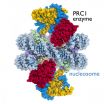(Press-News.org) MINNEAPOLIS-ST. PAUL (October 29, 2014) – A new standard of care for children facing acute myeloid leukemia (AML) may be clear, following a multi-year study published in the latest edition of the New England Journal of Medicine.
The research, led by John Wagner, Jr., M.D., director of the Pediatric Blood and Marrow Transplantation program at the University of Minnesota and a researcher in the Masonic Cancer Center, University of Minnesota, compared outcomes in children with acute leukemia and myelodysplastic syndrome who received transplants of either one or two units of partially matched cord blood. The study was conducted at multiple sites nationwide, between December 2006 and February 2012. Coordinating the study was the Blood and Marrow Transplant Clinical Trials Network (BMT CTN) in collaboration with the Pediatric Blood and Marrow Transplant Consortium and the Children's Oncology Group.
While the study found similar survival rates in both arms of the study, survival was overall better than in prior reports. This could create a new standard of care for pediatric patients for whom there is often an adequate single unit and adults for whom there is the need for a double unit should a single unit with an adequate number of blood forming stem cells may not exist.
Umbilical cord blood, a rich source of blood-forming stem cells, has previously been shown to benefit many patients with leukemia and myelodysplasia and other diseases, including bone marrow failure syndromes, hemoglobinopathies, inherited immune deficiencies and certain metabolic diseases. Cord blood offers several advantages for leukemia patients – there is no need for strict human leukocyte antigen (HLA) matching and or prolonged search for a donor.
"Based on promising early studies using two cord blood units in adults for whom one unit is often not sufficient, we designed this study in order to determine if the higher number of blood forming stem cells in two cord blood units might improve survival," explained Wagner. "What we found, however, was that both treatment arms performed very well with similar rates of white blood cell recovery and survival."
Children with blood cancer have previously been shown to benefit from umbilical cord blood, despite HLA mismatch, making it an important alternative for patients who cannot find a matched unrelated donor. However, the limited number of cells in a single cord blood unit obtained from a placenta after the birth of a child, has often curbed its potential benefits. The double UCB approach was pioneered at the University of Minnesota as a strategy to overcome this limitation.
Despite the similarities in survival rates, some differences were noted. Children transplanted with a single cord unit had faster recovery rates for platelets, the cell components important in clotting, and lower risks of GVHD, a condition where the transplanted donor blood immune cells recognize the patient's body as foreign causing a number of complications.
"This is helpful news for physicians considering the best treatment options for their patients," said Joanne Kurtzberg, M.D., chief scientific officer of the Robertson Clinical and Translational Cell Therapy Program, director of the Pediatric Blood and Marrow Transplant Program, co-director of the Stem Cell Laboratory and director of the Carolinas Cord Blood Bank at Duke University Medical Center. "We found children who have a cord blood unit with an adequate number of cells do not benefit from receiving two units. This reduces the cost of a cord blood transplant for the majority of pediatric patients needing the procedure. However, for larger children without an adequately dosed single cord blood unit, using two units will provide access to a potentially life-saving transplant."
"The involvement of multiple research partners was instrumental to the success of the study completion," added Dennis Confer, M.D., chief medical officer for the National Marrow Donor Program® (NMDP)/Be The Match® and associate scientific director for CIBMTR. "This trial is a testament to the importance of the BMT CTN and the collaboration of partners like the Children's Oncology Group."
Mary Horowitz, M.D., M.S., chief scientific director of CIBMTR and professor of medicine at the Medical College of Wisconsin, concurred. "Because of this tremendous collaboration, we were able to expand the scale of this research to multiple transplant centers across the United States and Canada. And the results will undoubtedly improve clinical practice, and most importantly, patient outcomes."
One provocative outcome of the study was the finding that significantly HLA mismatch cord blood had no detrimental effect on outcome. Future studies will take a closer look at how the HLA match within the cord blood unit impacts outcomes for patients, particularly those within minority populations.
INFORMATION:
Funding for this project was provided by the National Heart, Lung, and Blood Institute at the National Institutes of Health grant U01-HL069294 and the National Cancer Institute grants P01CA065493-21 and U10CA098543.
Visit to access the full study.
Masonic Cancer Center, University of Minnesota is part of the University's Academic Health Center. It is designated by the National Cancer Institute as a Comprehensive Cancer Center. For more information about the Masonic Cancer Center, visit http://www.cancer.umn.edu or call 612-624-2620.
The University of Minnesota Medical School, with its two campuses in the Twin Cities and Duluth, is a leading educator of the next generation of physicians. Our graduates and the school's 3,800 faculty physicians and scientists advance patient care, discover biomedical research breakthroughs with more than $180 million in sponsored research annually, and enhance health through world-class patient care for the state of Minnesota and beyond. Visit http://www.med.umn.edu to learn more.
Survival rates in pediatric umbilical cord transplants may indicate a new standard of care
Results of a multi-center trial published in New England Journal of Medicine
2014-10-29
ELSE PRESS RELEASES FROM THIS DATE:
First detailed picture of a cancer-related cell enzyme in action on a chromosome unit
2014-10-29
A landmark study to be published in the October 30, 2014 print edition of the journal Nature provides new insight into the function of an enzyme related to the BRCA1 breast-cancer protein. The study by a team at Penn State University is the first to produce a detailed working image of an enzyme in the Polycomb Repressive Complex 1 (PRC1) -- a group that regulates cell development and is associated with many types of cancer.
Enzymes like PRC1 turn on or turn off the activity of genes in a cell by manipulating individual chromosome units called nucleosomes. "The nucleosome ...
Strong bonds with pets may help foster resiliency in military-connected children
2014-10-29
NORTH GRAFTON, Mass. Developing resiliency has important benefits for children, especially those from military families faced with significant challenges such as parental deployment and frequent moves. New research published online in Applied Developmental Science supports the idea that, along with other key resources, strong attachments to animals may help military-connected children develop resiliency and other positive developmental traits.
"We were interested in seeing if the specific stressors faced by military-connected families could be mitigated by interacting ...
'Treasure in saliva' may reveal deadly diseases early enough to treat them
2014-10-29
UCLA research could lead to a simple saliva test capable of diagnosing — at an early stage — diabetes and cancer, and perhaps neurological disorders and autoimmune diseases.
The study, the most comprehensive analysis ever conducted of RNA molecules in human saliva, reveals that saliva contains many of the same disease-revealing molecules that are contained in blood. It was published online today by the peer-reviewed journal Clinical Chemistry and will be published in the journal's January 2015 special print issue, "Molecular Diagnostics: A Revolution in Progress."
"If ...
Plump turtles swim better: First models of swimming animals
2014-10-29
MADISON, Wis. — Bigger is better, if you're a leatherback sea turtle.
For the first time, researchers at the University of Wisconsin-Madison, Florida Atlantic University (FAU), and the National Oceanic and Atmospheric Administration (NOAA) have measured the forces that act on a swimming animal and the energy the animal must expend to move through the water.
A surprising finding: Longer, slender turtles are less efficient swimmers than more rotund turtles, which get better stroke for their buck.
By taking these measurements, the research team — led by UW-Madison's ...
UBC researchers aim to simplify life saving drug
2014-10-29
Heparin, the life saving blood thinner used in major surgeries and treatment of heart diseases, is a complicated drug but a research team from the University of British Columbia has set out to make its use a lot safer by developing a universal antidote.
Heparin's blood thinning action often requires an antidote to reverse its effect before serious bleeding issues arise especially in the case of major surgical procedures.
Finding an approved drug to reverse the blood thinning effect of heparin is complicated because there are about a dozen approved heparin products ...
Brain responses to disgusting images help reveal political leanings
2014-10-29
Maggot infestations, rotting carcasses, unidentifiable gunk in the kitchen sink – how much your brain responds to disgusting images could predict whether you are liberal or conservative.
In a study to be published in an upcoming issue of Current Biology, an international team of scientists led by Virginia Tech reports that the strength of a person's reaction to repulsive images can forecast their political ideology.
"Disgusting images generate neural responses that are highly predictive of political orientation even when those neural responses don't correspond ...
Innovative study using video games shows sleep apnea may affect memory of everyday events
2014-10-29
Sleep apnea may affect your ability to form new spatial memories, such as remembering where you parked your car, new research led by NYU Langone Medical Center sleep specialists suggests.
The study, published online Oct. 29 in Journal of Neuroscience, demonstrates through the playing of a specific video game that disruption of rapid eye movement (REM) sleep as a consequence of sleep apnea impairs spatial memory in humans even when other sleep stages are intact.
Spatial memory is utilized for everyday tasks, such as remembering the location of a favorite restaurant, ...
NASA sees Tropical Cyclone Nilofar being affected by wind shear
2014-10-29
Wind shear has kicked in and has been pushing clouds and showers away from Tropical Cyclone Nilofar's center. NASA's Aqua satellite captured an image that showed the effects of the shear on Oct. 29.
The Moderate Resolution Imaging Spectroradiometer aboard NASA's Aqua satellite captured an image of Tropical Cyclone Nilofar on Oct. 29 at 09:00 UTC (5 a.m. EDT). Tropical Cyclone Nilofar is moving through the Arabian Sea. The image shows that clouds were being pushed to the northeast of the center of the storm, from strong southwesterly wind shear.
On Oct. 29 at 1500 UTC ...
Researchers uncover new evidence revealing molecular paths to autism
2014-10-29
In the largest study of its kind to date, researchers have used DNA sequencing to uncover dozens of genes that heighten the risk for autism. Joseph Buxbaum, Ph.D., Icahn School of Medicine at Mount Sinai, New York City, Mark Daly, Ph.D., Broad Institute of Harvard and MIT, and their colleagues examined more than 14,000 DNA samples from affected children, parents and unrelated people. They identified changes in 107 genes that are likely to contribute to the risk for autism spectrum disorder (ASD) – a jump from the nine genes implicated in earlier studies using these ...
Changes in scores of genes contribute to autism risk
2014-10-29
Small differences in as many as a thousand genes contribute to risk for autism, according to a study led by Mount Sinai researchers and the Autism Sequencing Consortium (ASC), and published today in the journal Nature.
The new study examined data on several types of rare, genetic differences in more than 14,000 DNA samples from parents, affected children, and unrelated individuals – by far the largest number to date – to dramatically expand the list of genes identified with autism spectrum disorder (ASD).
Most of the genes that contribute to autism remain ...
LAST 30 PRESS RELEASES:
Why nail-biting, procrastination and other self-sabotaging behaviors are rooted in survival instincts
Regional variations in mechanical properties of porcine leptomeninges
Artificial empathy in therapy and healthcare: advancements in interpersonal interaction technologies
Why some brains switch gears more efficiently than others
UVA’s Jundong Li wins ICDM’S 2025 Tao Li Award for data mining, machine learning
UVA’s low-power, high-performance computer power player Mircea Stan earns National Academy of Inventors fellowship
Not playing by the rules: USU researcher explores filamentous algae dynamics in rivers
Do our body clocks influence our risk of dementia?
Anthropologists offer new evidence of bipedalism in long-debated fossil discovery
Safer receipt paper from wood
Dosage-sensitive genes suggest no whole-genome duplications in ancestral angiosperm
First ancient human herpesvirus genomes document their deep history with humans
Why Some Bacteria Survive Antibiotics and How to Stop Them - New study reveals that bacteria can survive antibiotic treatment through two fundamentally different “shutdown modes”
UCLA study links scar healing to dangerous placenta condition
CHANGE-seq-BE finds off-target changes in the genome from base editors
The Journal of Nuclear Medicine Ahead-of-Print Tip Sheet: January 2, 2026
Delayed or absent first dose of measles, mumps, and rubella vaccination
Trends in US preterm birth rates by household income and race and ethnicity
Study identifies potential biomarker linked to progression and brain inflammation in multiple sclerosis
Many mothers in Norway do not show up for postnatal check-ups
Researchers want to find out why quick clay is so unstable
Superradiant spins show teamwork at the quantum scale
Cleveland Clinic Research links tumor bacteria to immunotherapy resistance in head and neck cancer
First Editorial of 2026: Resisting AI slop
Joint ground- and space-based observations reveal Saturn-mass rogue planet
Inheritable genetic variant offers protection against blood cancer risk and progression
Pigs settled Pacific islands alongside early human voyagers
A Coral reef’s daily pulse reshapes microbes in surrounding waters
EAST Tokamak experiments exceed plasma density limit, offering new approach to fusion ignition
Groundbreaking discovery reveals Africa’s oldest cremation pyre and complex ritual practices
[Press-News.org] Survival rates in pediatric umbilical cord transplants may indicate a new standard of careResults of a multi-center trial published in New England Journal of Medicine




